Have you ever been in the middle of delivering a great lesson that’s full of important information only to look out and realize none of your students are taking notes? It’s not surprising—many kids these days expect handouts or other materials they can refer back to later. But taking notes is actually a pretty important skill for kids to learn. Here’s why, along with some note-taking strategies they should try.
Why are good note-taking strategies important?
Study after study has shown the importance of actively taking notes rather than passively reading a handout later on. The act of writing engages different parts of the brain, forging new pathways that help students retain information in long-term memory.
What’s more, the studies show that the more detailed the notes, the better. And using different note-taking strategies helps too. In some cases, a general outline can be effective. But when you want students to analyze the content, encouraging charting or mapping can be more helpful.
One more good reason to learn to take notes? It’s a skill we use throughout our entire lives. Most jobs require you to be able to take notes during meetings or other activities so you can refer back to them later on. Adults use note-taking strategies on a regular basis, so teaching kids the skill early on will help them succeed later in life.
Digital vs. Handwritten Notes
There’s a lot of discussion these days about whether handwriting notes is better than typing them on a computer. Some worry that the digital devices themselves serve as too much of a distraction. When kids aren’t taking notes, they might be browsing the web, playing games, or sending each other messages instead of participating in the lesson. Others wonder if typing is less effective than handwriting when it comes to retaining information.
Science is still out on whether handwritten notes are better than digital. Some studies say that handwriting is better for learning, while others note that many people type faster than they write, enabling them to take more complete notes that way. And those who have dysgraphia or other learning disabilities should be able to take notes in the way that suits them best. See more arguments from both sides here.
Graphic Organizers
Many teachers use what’s called “structured note taking” in their classrooms. They provide easy-to-read graphic organizers that only require students to write in specific information. Learn more about graphic organizers here.
This is an excellent beginning strategy that enables students to grasp difficult concepts and focus on content and connections. But students should also learn to take notes from scratch. After all, in real life, the most they’re likely to get is a printed agenda for a meeting. They’ll need to know how to capture the important points themselves.
General Tips for Taking Good Notes
Ultimately, what’s most important is that students learn to take notes, period. Whatever method or strategies they choose, the key is having information in their own words they can return to later when they need to review and study. Here are some general tips to share with your students.
- Focus on recording the main points of the lesson. Listen for key words and phrases, but don’t try to frantically write everything you hear.
- Try to summarize the information in your own words rather than writing down the teacher’s words verbatim. Write your notes in a way that will make sense to you later on.
- Jot down words you’re unfamiliar with or confused about and look them up later. Consider circling these words, so they’re easy to spot when you’re reviewing your notes later.
- Add color, either while you’re taking notes or later on, with a highlighter. Color helps show relationships between concepts, and it engages the brain better too.
- Don’t be afraid to ask your teacher to repeat something if you feel like you missed it. If you feel like you can’t interrupt, put a star by that section to remind you to ask about it after class.
- If your handwriting is hard to read, or you think you can organize the information in a better way, go ahead and re-copy your notes after class. It’s a good way to reinforce the information too.
Symbols and Abbreviations
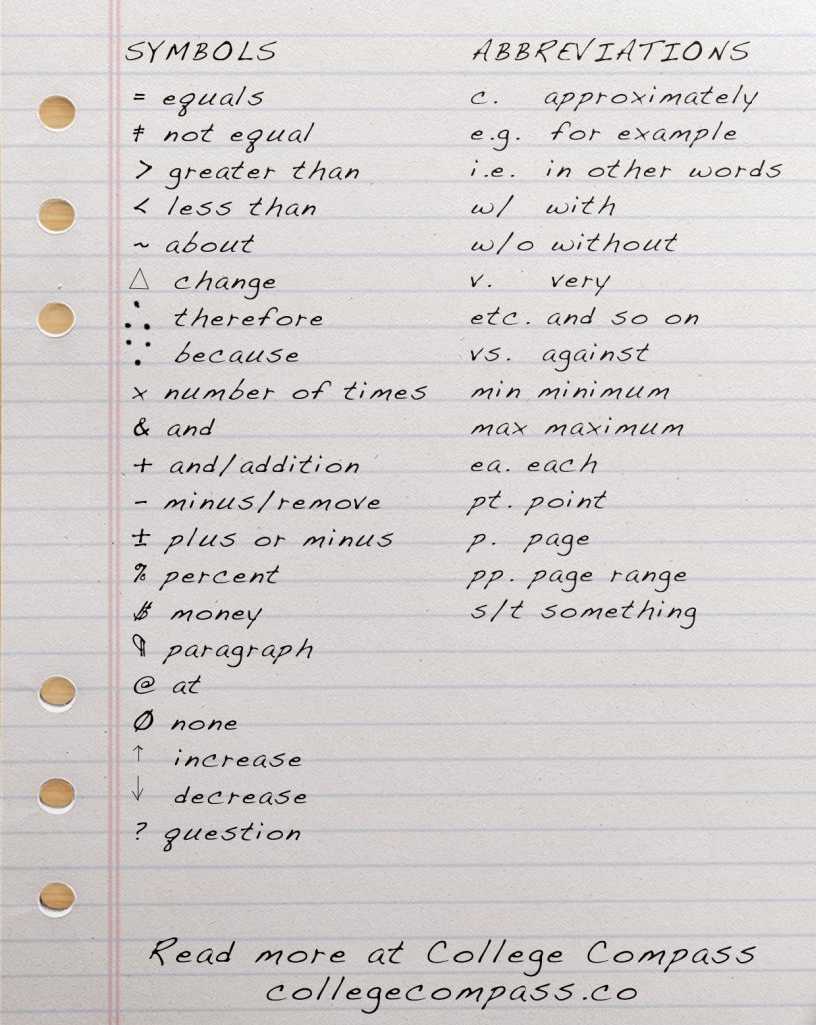
Source: College Compass
Using standard note-taking symbols and abbreviations can be really helpful. There’s no need to memorize all of them at once; choose a few that seem the most useful and give them a try. You can add more as you get better at taking notes. Refer to the chart above for a good list.
Common Note-Taking Strategies
Finding a note-taking method that works is key. Depending on the subject, it can be useful to have several different strategies available, so you can use whatever makes the most sense. These are some common methods used by students of all ages.
Boxing Method
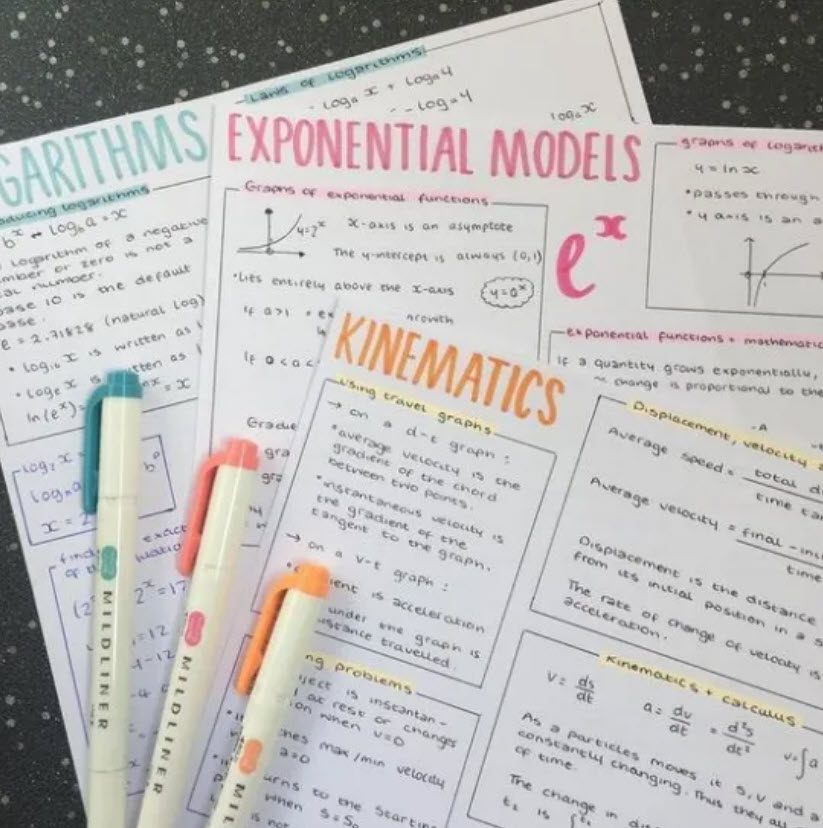
Source: Society19
For students who have trouble keeping things organized (including their thoughts), the boxing strategy can be very helpful. Each box contains a complete concept, idea, or category. Adding extra colors with pens or highlighters makes things even better. Boxing is a fairly new note-taking strategy, one that’s gained popularity among college students who take notes on digital devices. But it also works well with handwritten notes.
How it works: Start a box on the page, but don’t draw the fourth line on the bottom. Take your notes inside that box, keeping everything relating to one idea or concept together. When you’re done with that section, draw the final line to close the box, and begin a new one. (If you’re using a tablet or laptop instead, you can draw a text box instead. It will automatically resize as you work.)
Learn more: Boxing Method at University Librarian
Charting Method
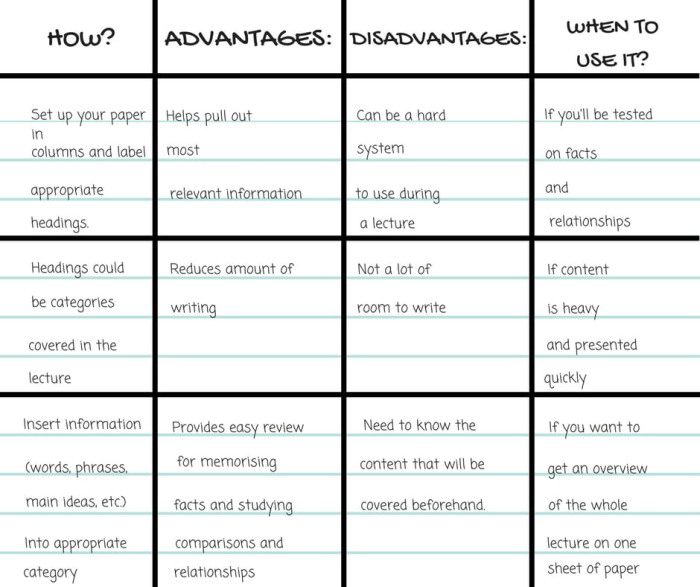
Source: The University of Auckland
When you need to organize, compare and contrast, or categorize, use the charting method. It’s simple and easy and works well digitally or when taking notes by hand.
How it works: Draw lines to divide the page into columns and rows. Write headers on the columns (and rows, if necessary). As you take notes, put the information into the appropriate place on the chart. It’s that simple.
Learn more: GitMind
Cornell Note-Taking Method
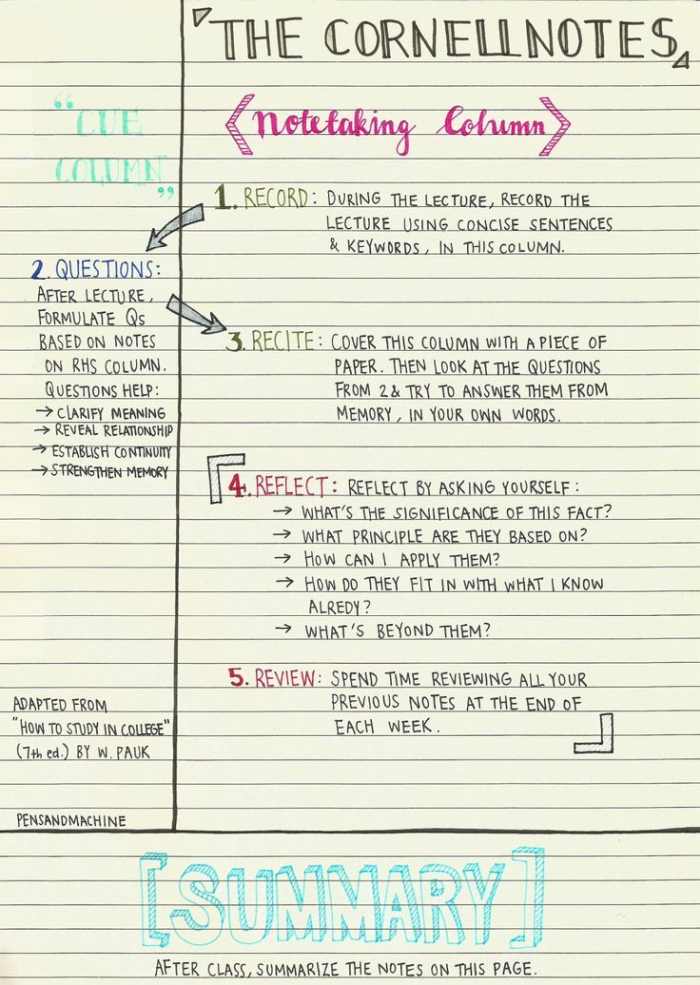
Source: Think Insights
The Cornell method is more than just a note-taking strategy. It offers tips on how to use notes after class for studying too. Cornell University professor Walter Pauk created this method in the 1950s. Others quickly adopted it, since it’s easy to learn and has been proven to help students learn.
How it works: Divide a page into two columns. The wider column on the right is the Notes column. Here, take concise notes during class, capturing keywords and other important information. Leave space across the bottom of the page or section for the Summary, which you’ll complete after class. This is the space for a brief overview of what was covered.
The left-hand column is known as the Cue column. Use it after class to write review questions that relate to the information in your notes. Then, cover up the Notes section and try to answer the questions in the Cue column. Take some time to reflect on the information, making connections and evaluating what you’ve learned. At the end of each week, review all of the notes you’ve taken to reinforce the learning.
Learn more: Cornell University
Mapping Method
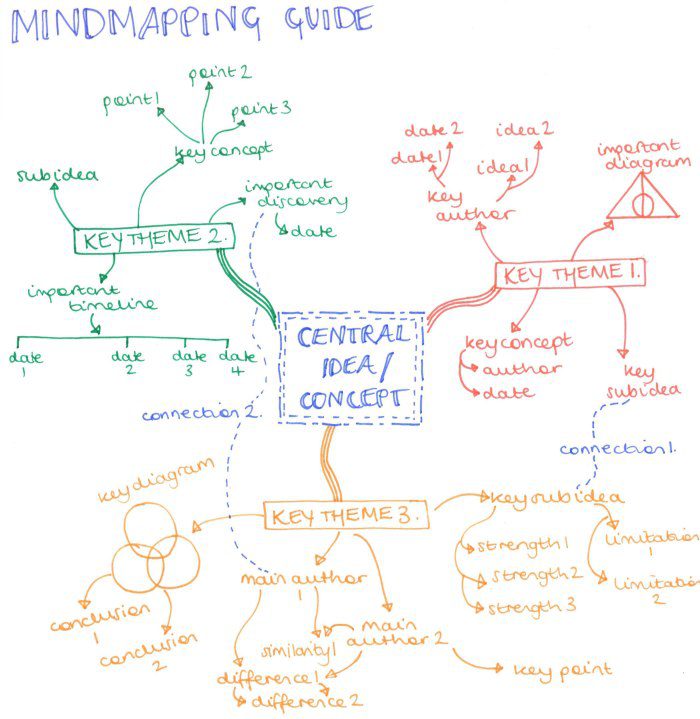
Source: Chloe Burroughs
This method is terrific for visual learners, as it helps show the connections between main points and supporting details. It’s also helpful for analyzing and evaluating content, rather than just writing it down. Fun fact: Leonardo da Vinci used this method!
How it works: Start by writing a main topic in the middle of the page. If you like, you can use the same color for all your main topics, then switch to different colors as you add and connect subtopics. Continue to add supporting details where they fit, drawing lines and arrows to note connections. Switch to a new page to begin a new main topic.
Learn more: e-student.org
Outline Method of Note Taking
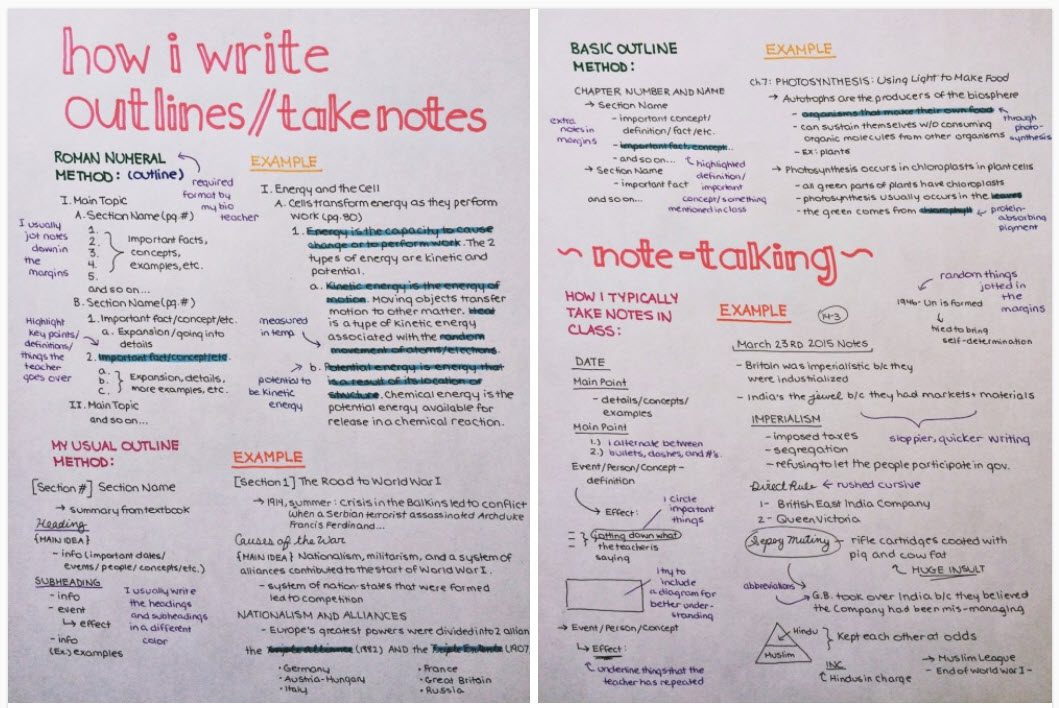
Source: A Day to Study
This is one of the oldest methods of note taking, and one most kids learn somewhere along the way. You can teach them to use the standard Roman numeral and lettering/numbering system. Or just use bullet points and dashes to simplify things. This logical strategy works well in nearly any subject.
How it works: Start a main topic to the farthest left on the page. Add subtopics and supporting details on the lines beneath, indenting them slightly:
Main Topic
-
- Subtopic
- Supporting Detail
- Supporting Detail
- Subtopic
- Supporting Detail
- Supporting Detail
- Subtopic
Start the next main topic all the way to the left, and continue your notes. Rather than writing long sections, try to keep your notes to just key words and phrases, enough to jog your memory later on.
Learn more: Medium
Sentence Method
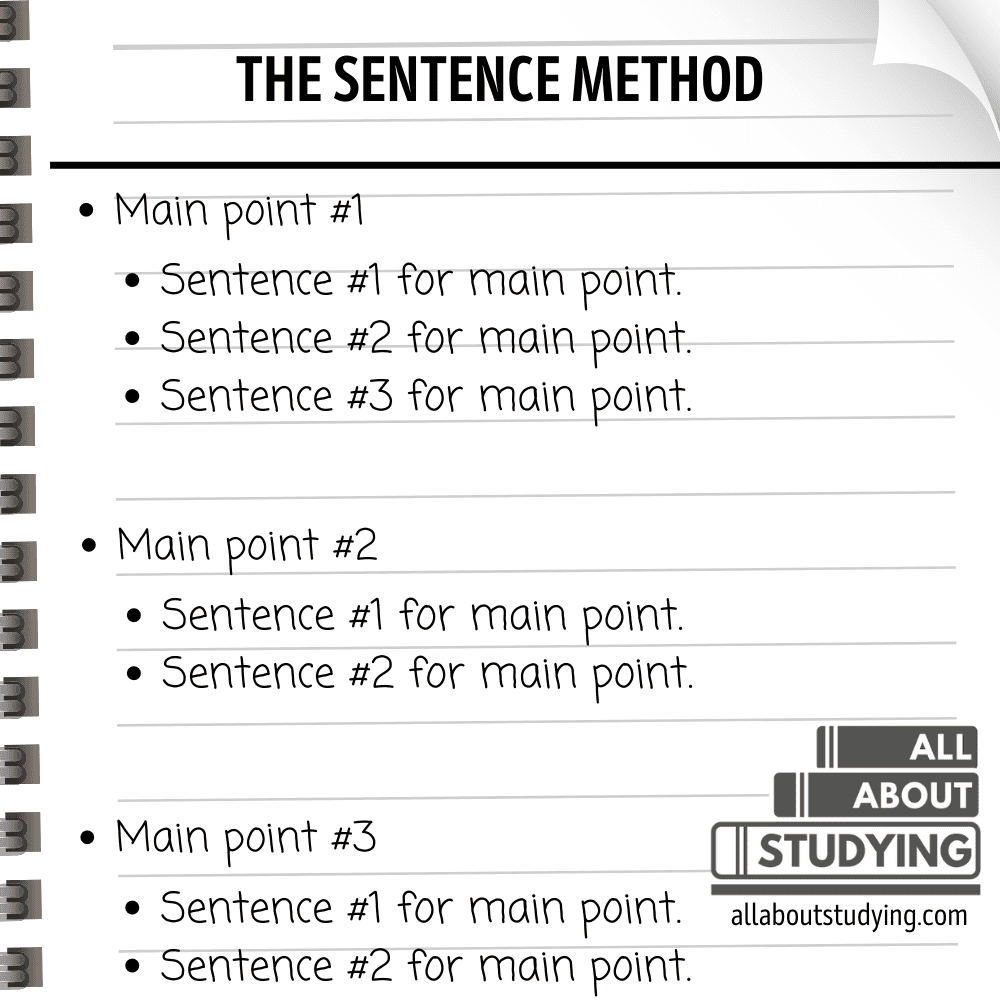
Source: All About Studying
The sentence method looks similar to the outline method, but it includes much more information. As the name implies, students write full sentences for each line. This requires the ability to write (or type) quickly and is best for students who have mastered both these skills. One benefit to the sentence method is that you’re likely to have more complete notes to refer to after class.
How it works: Start a topic by writing the main point on one line. On the lines beneath it, add bullet points and a full sentence describing the supporting information. Be sure to use your own words rather than the teacher’s. This ensures you’re fully understanding the information rather than just recording what you hear.
Learn more: Sentence Method at University Librarian
Sketchnotes
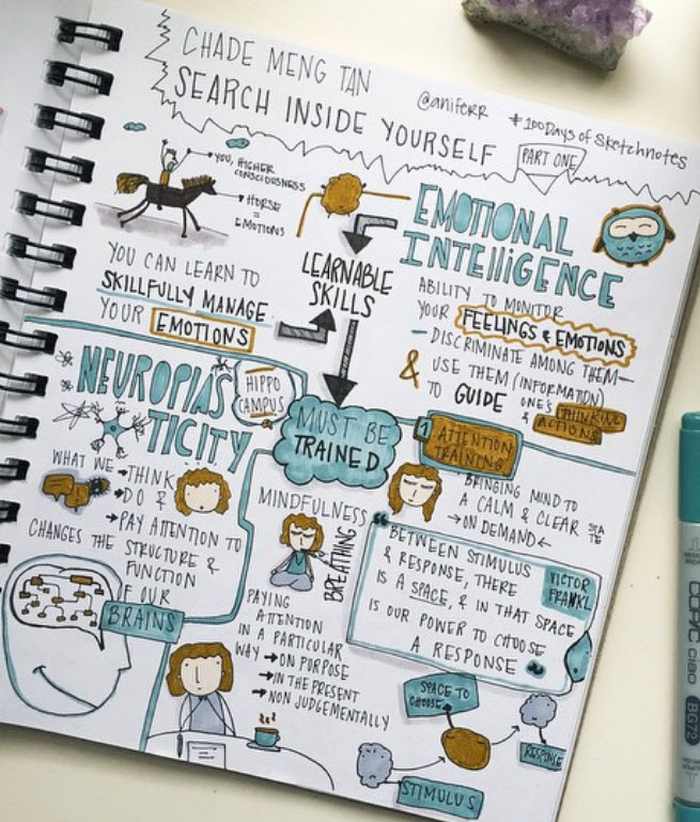
Source: @aniferr
Sketchnotes are fairly new but have a real appeal for those who learn best visually. They combine elements of mapping or boxing with meaningful doodles. The colorful result is fun to look at, and some students may retain images better than words.
How it works: There aren’t a lot of rules with Sketchnotes. Basically, students should try to capture keywords and important phrases, then add images that help them connect with the topic. Block lettering and other doodles are fun to add too.
Learn more: 8 Creative Ways To Use Sketchnotes in Your Classroom